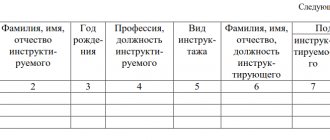The standards set out in legislative acts stipulate that any employer is required to provide fire safety training (a sample is freely available). This applies to everyone without exception, regardless of the form of ownership of the business. That is, this should be done by both the director of a large enterprise and an individual entrepreneur, under whose supervision there is one or two employees. In this case, the briefing mainly concerns those employees who are entering work for the first time or are transferring to it. And it is called primary.
What is fire safety training in the workplace?
In accordance with clause 3 of the Fire Safety Rules established by Decree of the Government of Russia dated September 16, 2020 No. 1479, persons hired by an organization or individual entrepreneur are allowed to perform their duties only after they have been trained in the necessary fire safety measures.
It can be carried out under fire safety training programs or additional vocational education programs. Based on the provisions of paragraph 5 of the appendix to the order of the Ministry of Emergency Situations of Russia dated December 12, 2007 No. 645, fire safety training can be understood as a set of measures aimed at informing employees of organizations:
- about basic fire safety requirements;
- about the fire hazard features of individual technological processes and devices;
- on methods of using fire protection equipment;
- procedure in case of fire.
The content of fire safety training should, in accordance with clause 8 of Order of the Ministry of Emergency Situations No. 645, include familiarization of employees with:
- with the rules for using the territory, buildings, premises, in particular, the evacuation routes, water supply, fire alarms and evacuation control systems available in them;
- fire safety requirements, determined based on the characteristics of technological processes and production infrastructure and their fire hazard;
- specific measures aimed at providing fire protection;
- rules for the use of open fire, as well as hot work;
- rules for calling fire services, using various fire extinguishing agents.
There are five types of fire safety training:
- induction (carried out with new employees);
- initial fire training at the workplace (usually carried out with employees who are transferred from one position to another);
- repeated (carried out once every six months);
- unscheduled (carried out in case of significant changes in the fire safety regime at the enterprise, as well as during long breaks in work);
- targeted (carried out within the framework of a specific event or task with the participation of employees).
The procedure for each stage of the instruction is described in detail in ConsultantPlus. Sign up for free for 2 days and you'll learn how to coach properly.
Legislative framework and content
According to Article 225 of the Labor Code and government regulations, all persons involved in work activities (including heads of departments) must periodically undergo fire safety training. This event is carried out in order to eliminate possible incidents in flammable industries that could lead to a fire with subsequent unpredictable consequences.

The organization of on-the-job training is part of the work carried out at the enterprise as part of labor safety activities in each of its divisions (Article 25 of Law No. 69-FZ of December 21, 1994). It covers the following important issues related to fire safety in the workplace:
- how to properly move around the territory of the enterprise and production premises, taking into account the evacuation routes available on them and respond to emergency warning signals about fire danger;
- what fire hazards are present in the technological chains involved in this production;
- familiarization with specific preventive measures aimed at eliminating the risk of fire or accidental combustion;
- familiarization with the list of rules for the use of open fire for a specific type of operation in the workplace (when welding, cutting, melting metals, as well as when heating rooms and similar procedures);
- the procedure for notifying about fire danger and using special fire extinguishing means;
- preliminary training in safe work methods and familiarization with basic techniques for providing emergency medical care in case of fire.
All this information must be communicated to each person being instructed individually, which is confirmed by his personal signature in the appropriate document (in a special journal).
Stages of fire safety training
All types of instruction must be carried out by a responsible employee who is appointed by the head of the company (clauses 12, 17, 22, 27, 29 of the appendix to the order of the Ministry of Emergency Situations No. 645) with the issuance of the corresponding order, the conclusion between the employer and the employee of an additional agreement to the employment contract, as well as the signing updated job description (if the employee’s original duties did not include such activities). This is the first stage of instruction.
Introductory and initial fire safety training must be carried out by the employing company in accordance with special programs approved by management (clause 6 of the appendix to the order of the Ministry of Emergency Situations No. 645).
Repeated fire safety instruction is carried out according to the primary program. Unscheduled and targeted briefings do not involve drawing up a program, and the algorithm for conducting them is determined based on the specific objectives of the employing company.
The second stage of training (introductory, primary, repeated) is the development of a program for it. When solving this problem, the employer can use the recommended lists of issues that should be covered by the program - they are defined in Appendix No. 2 to the Order of the Ministry of Emergency Situations No. 645.
The next stage of fire safety training is determining the schedule for workers’ participation in it.
And finally, the briefing itself, carried out on the basis of a schedule and program approved by management.
As a rule, the most difficult and labor-intensive stage of conducting fire safety training is drawing up a program. Let's consider in what structure it can be presented.
Forms for familiarizing yourself with the rules
Depending on its content and timing, fire safety training can be carried out in the following forms:
- an introductory (or initial) interview on the basics of fire safety conducted with incoming employees;
- initial briefing organized for persons transferred to a new position;
- re-familiarization with the rules of safe handling of fire (carried out at least once every six months);
- unscheduled briefing, the need for which is caused by changes in the fire safety regime of the enterprise or significant interruptions in the employee’s activities;
- targeted briefing arranged before specific types of “hot” work.
The frequency of fire safety interviews is determined according to their purpose. You should not approach the issue of workplace instruction formally, since life depends on knowledge of fire safety.
What should be included in the initial fire safety training program at the workplace?
Depending on the preferences of the employer, separate programs can be compiled for briefings of different types, or one can be formed, containing in its structure sections with questions relevant to a specific type of briefing - introductory, primary or repeated.
A program (or section) reflecting the specifics of induction training may include instructions on informing employees about:
- the field of activity of the employing company in those aspects that are important from the point of view of fire safety;
- a list of duties and responsibilities of employees for compliance with fire safety standards;
- basic information reflecting the specifics of the fire safety regime at the enterprise;
- a list of local regulations establishing fire safety standards at an enterprise, as well as their key provisions;
- availability of safety instructions, ways to access them, as well as advice on their use;
- the main factors in the occurrence of fire hazards at the enterprise;
- ways to effectively use fire extinguishing means, measures to respond to an emergency situation.
The initial and repeated briefing program may include provisions on:
- features of the evacuation plan in accordance with the locations of fire extinguishing equipment;
- fire factors that may be observed in certain workplaces or areas of the enterprise;
- fire hazard of the raw materials used, materials, manufactured products;
- fire hazard of certain sections of the technological process;
- established measures of employee responsibility for compliance with fire safety standards;
- types of fire extinguishers used in the organization;
- requirements established for extinguishing electrical equipment;
- recommended actions for employees in case of smoke or when a fire is detected;
- ways to inform other employees, as well as emergency services, about a fire;
- practical measures to protect yourself and colleagues in the event of a fire;
- ways to provide assistance to victims.
The structure of the fire safety briefing program can be represented by sections about:
- general provisions of the program;
- the goals and objectives of the briefing;
- features of organizing and conducting training at the enterprise.
Introductory fire safety training program - Examples, Samples.
Within the Fire Safety and Download File format. You can download 9 files for free . Of these: 7 documents - Programs for conducting introductory fire safety training ( examples, samples ); 2 documents - Programs for conducting introductory fire safety training ( SLIDE SHOW )
Please note that the programs were published on the blog at a time when PPB 01-03 was in effect. This document is now no longer in force. Documents need to be updated.
1. Program for introductory fire safety briefing + Instructions for introductory fire safety briefing []
File data Archiving: RAR; Size: 10 Kb; Word document: 5 pages.
2. Program for introductory fire safety training (with illustrations) []
File data Archiving: RAR; Size: 73 Kb; Word document: 7 pages.
3. Program for introductory fire safety training (sample, example) []
File data Archiving: RAR; Size: 7 Kb; Word document: 3 pages.
4. Program for introductory fire safety briefing + List of questions for introductory fire safety briefing + Table. Timing for checking fire extinguishing parameters and recharging fire extinguishers []
File data Archiving: RAR; Size: 16 Kb; Word document: 10 pages.
5. Program for conducting introductory fire safety briefings, taking into account the main regulatory documents on fire safety []
File data Archiving: RAR; Size: 13 Kb; Word document: 10 pages.
6. Program for conducting introductory fire safety briefings + Program for conducting repeated, unscheduled, targeted fire safety briefings at the workplace in the tables []
File data Archiving: RAR; Size: 11 Kb; Word document: 3 pages.
7. Program for conducting initial (repeated) briefing on fire safety in the workplace + List of main questions for initial (repeated) briefing on fire safety []
Training in occupational safety and related areas in a Virtual Production Environment using Electronic Simulators + issuance of certificates. Like this?
File data Archiving: RAR; Size: 7 Kb; Word document: 3 pages.
+ BONUS for conducting training in a more modern context








